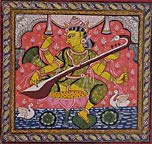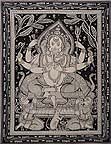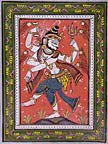IV. Themes Related to Gods and GoddessesAlthough Jagannath and Krishna are perhaps the most common subjects of the pata-chitras, other gods and goddesses appear frequently in these pictures. We have already seen that there are many pictures of the dasavatara type that represent one of the ten incarnations of the god Vishnu. Pictures of goddesses Lakshmi and Saraswati are popular. One may also readily find images of other goddesses such as Kali, Chamunda, Chandi, Chinnamasta, and Durga; of the hero-god Rama; and of the gods Siva and Ganesh.
Sarasvati, the goddess of wisdom, learning, and music, is shown in the exceptionally finely executed pata-chitra in Figure 26. In the iconography of Sarasvati, she is typically four-armed, and in her four hands she holds a book, a vina (a type of stringed instrument), a rosary, and a water pot. These items associate her with learning, music, spiritual practice, and religious rites. Sarasvati's vahana (the animal vehicle upon which Hindu deities are thought to ride) is the swan. Her color is gleaming white for purity; her demeanor is serene; and she sits upon a lotus flower, symbolizing transcendence.31 In this pata-chitra, the goddess holds a vina in two of her hands, a book and an unidentified object in her other two hands. The book, however, is in the form of a manuscript written on palm leaves, a traditional format for a book in Orissa. She sits on an open lotus flower above the water. Two swans, representing her vahana, or vehicle, swim in the water. A deity's crown rests on Sarasvati's head. Contrary to the standard iconography, however, the goddess is yellow instead of white. This painting has features that are both similar to and different from that of a typical pata-chitra. Its double border is a common feature. The outer border includes a branch, leaf, and flower motif. The inner border is a finely detailed drawing on an ochre ground of flowers on either side of a wavy line. A unique feature of the picture is the goddess's theatrical setting. We see the capitals of two columns - themselves not visible, being just outside the picture border - on top of which rest arches, from the middle of which hang draperies. Also of note in this pata-chitra is the black-on-white design in the arches. Although, as discussed elsewhere in this article, there are pata-chitras painted in black and grey on white, it's a little unusual to see a black-and-white area in an otherwise brightly colored painting. The background contains typical stylized forms but the color scheme is enlivened with the addition of grey, ochre, and brown to the common mix of red, blue, yellow, green, black, and pink. In contrast to the fine detail and precision in the inner border, the arches, the column capitals, the goddess's crown, and parts of her clothing, the dabs of paint that represent ripples in the water are sketchy and impressionistic. Finally, although occasionally touches of red are used around the eyes of figures in pata-chitras, it is interesting that the artist, in this painting, has made the red accent so strong. |




